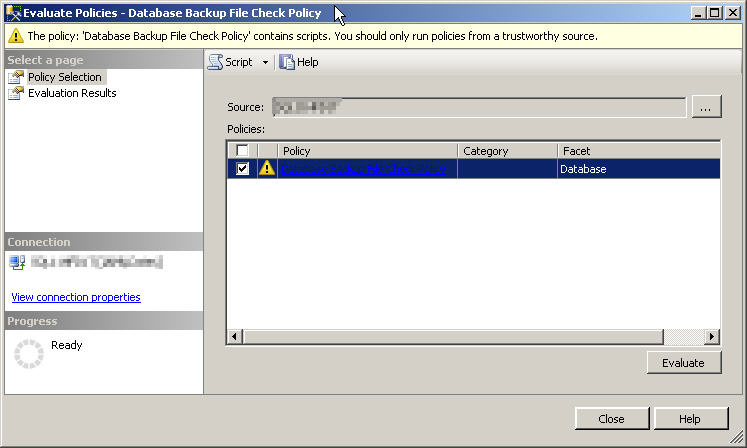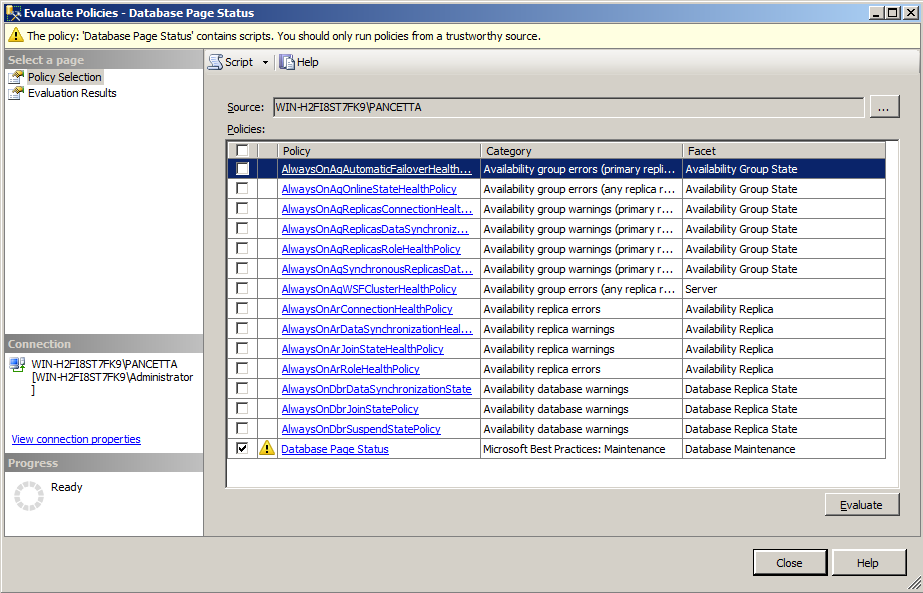The truth is this: It works.
Oh sure, the process may be slower than molasses in the winter. And the overall experience may be as frustrating as helping your parents with their email. But it really does work. Here is my example.
I was using the Google the other day and came across this Connect item: https://connect.microsoft.com/SQLServer/feedback/details/481566/policy-evaluation-screen-is-difficult-to-read
Yeah, that *is* me, submitting an enhancement request back in August of 2009. The “feature” of SQL Server Management Studio bugging me was this:
“If I have a policy that contains a script I get prompted by SSMS with a screen that is very difficult to read due to the blue hypertext on top of a blue row fill color.”
That pretty much says it all, but here is a picture of what SSMS looked like back then:

Not exactly what I would call “readable”.
And what did Microsoft do when they read my request? They quickly marked it as ‘resolved (won’t fix)’ and without any comment. One of the biggest issues people have with Connect has to do with poor communication received back from Microsoft. This is a perfect example. In this case ‘resolved (won’t fix)’ is not the right answer, but there is no option for ‘thanks, we can fix this for a future version, but not for the most current one’. So I named it “PBM Blue” because that’s what you do for problems in which there appears to be no solution, right? I would use “PBM Blue” often with members of the tools team at Microsoft. I don’t think they appreciated it very much.
If you read the stream of comments you see remarks that the use of default schemas is the issue. So, nothing for them to fix.
This feedback was also told in a private and direct manner from the tools team to me during the MVP Summit. My guess is they got tired of hearing me yell “PBM BLUE” during sessions.
And I believed them, until 10 months later, when Clifford Dibble simply wrote “This will be fixed in the next major release SQL Server. The code was checked in today.”
So, we went from “It’s impossible”, to “Yeah, that’s done”, in a ten-month span. And then the wait began. First, I waited for the next major release of SQL Server. I wanted to see how they fixed this minor nit with SSMS. Then, I waited some more.
And then I forgot all about it. Until two days ago.
That’s when I remembered that last week I did a video that used PBM. I was using a policy that had a script. And I didn’t recall having an issue with readability. I wondered why, so I went back and looked at it again and saw this:

Do you see what they did there?
With a row in focus the row text is alternated to a white font, instead of staying blue. This is functionality that has been around for…oh…decades. When PBM was launched, this functionality was overlooked. Well, I don’t know if it was overlooked. I wasn’t in those meetings. But for whatever reason, it didn’t get into the product the first time around. It took feedback from customers to get this changed.
Don’t give up on Microsoft Connect. The process is not perfect but it can (and often does) work.



Curiosity – do you think it was finally fixed because you had a voice with MS that we don’t have or because users up-voted the issue? The main issue is the first one you listed – “Closed, won’t fix.” as the default answer from MS. If we actually take the time to go through the Connect system to submit some feedback, it means that the issue is important enough to go through that process. To have that issue then closed with no comment and what usually seems to be no thought behind it discourages people from using the system MS has in place to gather feedback.
Sure, the process works sometimes, but the communication to the users is still very much broken as you pointed out here. Even getting a small explanation with an explanation like “We’re not planning to fix this because” would feel a little better than what feels like someone just opening the queue and clicking the “Closed won’t fix” button until the queue is empty.
I’m glad that your issue was resolved. I’ve mostly given up on Connect unless there’s something really, really bad that I’ve come across because the process feels like a lost cause for anything else. (But maybe that’s part of the story behind Connect…. 🙂 )
Peter,
I doubt my voice had anything to do with it being fixed. Chances are it was something that could get done, and then did get done.
The communication to the users is something we hound MS all the time about, so I know they are aware of the disconnect most people have right now with Connect.
Tom
Agreed. I’ve had any amount of frustrations with Connect but a fair few successes too. And to be honest I don’t think Microsoft get enough credit for having such an open avenue for feedback – I don’t know of any other company that does it.
The worst thing about Connect in my opinion is that as a functioning website it is simply horrible. Slow, ugly and difficult to navigate.
@jamiet:twitter
I don’t think Microsoft’s feedback mechanism is unique to the industry. MySQL has a public bug tracker (
http://bugs.mysql.com/) as does JetBrains (http://jetbrains.net/jira/secure/Dashboard.jspa).
I think connect is a great thing. However, its not unique.
Tom, glad to see your fix made it in.
This actually illustrated one of the advantages of open source, you have the option to fix it your damn self. I’ve never had one of my connect bugs fixed. I also have my share of un-addressed and addressed bugs in other bug trackers for both open and closed source products.
Not everyone can and will spend a Saturday or two fixing a bug in some open source product they use. Somethimes its ability. Not everyone is a programmer. I’m also not saying that Microsoft necessarily should open source Sql Server (although if they gave me the code for SQLCMD I’d submit a patch or two for that). I’m just saying that having used open source projects, its a nice option to have.
Justin,
That is an interesting point to make. However, wouldn’t your software end up in a Wikipedia-like state of affairs, where everyone would assume it is good, but it isn’t? When it comes to something like security, for example, I’m not sure I want to trust that code being open.
But I do see your point.
Thanks for the comment!
Tom
Tom,
I’m not suggesting wikipedia like openness where submission review is after the fact. I don’t know of any open source project that works that way.
Although, that does bring up an interesting point. Sometimes it takes a while for a patch to be accepted and pushed to a release. However, I have the option of using my fork in the interim.
As far as security, that one reason foot patches to be reviewed.
My personal experience could be best viewed as: aggravated. I have a ticket that’s been open for 6 years.
Michael,
What is the Connect ID? I would like to see the details of that one.
Tom
Aggravation is the key word. Connect is like the DMV. Its very efficient, but very impersonal.
Hey Tom, do you search for duplicates before submitting your items? I filed this in 2007. 🙂
http://connect.microsoft.com/SQL/feedback/ViewFeedback.aspx?FeedbackID=281293
Of course my bug is still closed as “by design” since they were (poorly) following the Windows color scheme. But at least we know whose bugs they pay attention to and whose bugs they don’t.
Yeah, you are prompted to do a search before you submit. Also, in my ticket, it was noted that you had already filed one previously. My guess is that you are still way ahead of me on the number of bugs that have been fixed as a result of submitting a Connect item.